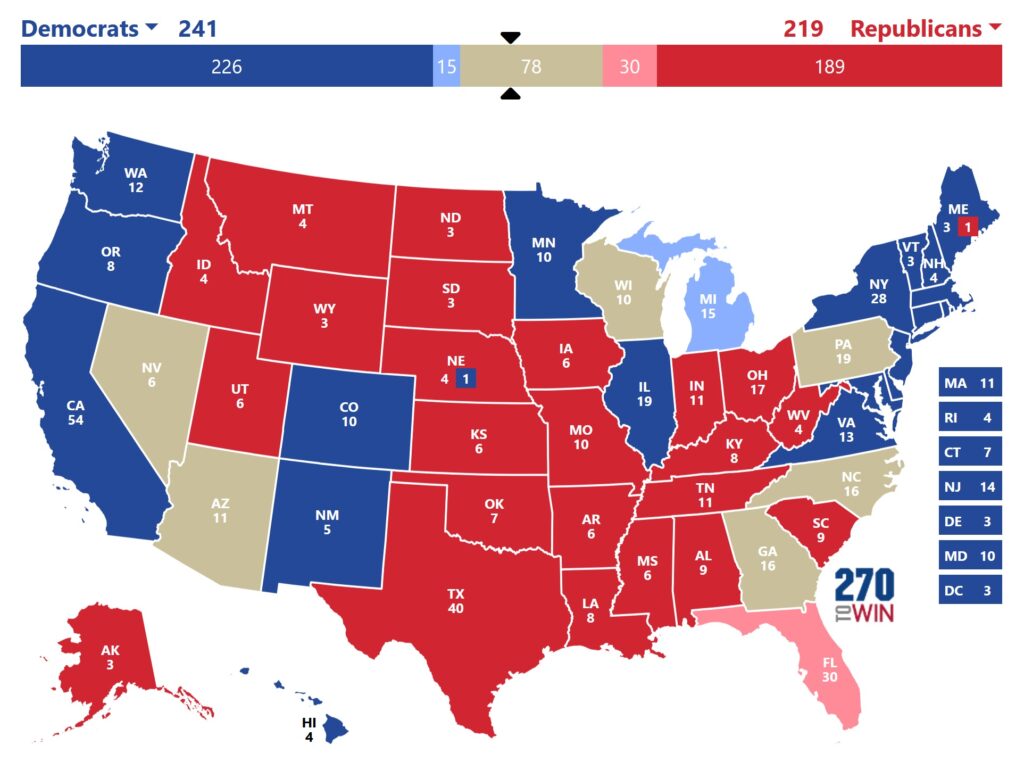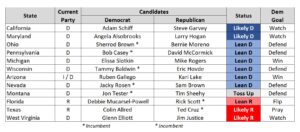I seriously doubt that this post will mark my return to regular blogging. However, I’ve been thinking about this particular topic quite a lot lately. I needed to write things down to organize those thoughts and decided I might as well share.
I’ve been at a complete loss trying to determine what Democrats (and other non-cultists) can actually DO at the moment. Most of the party’s actions to-date have ranged from disorganized and deluded, through desperate and pathetic, all the way to ludicrous and idiotic. Trump & Company are gleefully walking all over Democrats (and Congress, and the Courts, and the American People, and the world in general).
Below is a modest structural proposal to get Democrats off the sidelines and back into the game.
At a high level, the proposal is based on the concepts of warfare. Make no mistake. We are at war — a war that Trump instigated and is relentlessly pursuing with the flaccid blessing of the remnants of the Republican party. Democrats need to stop acting like they’re auditing a junior high school civics class. While I’m not advocating that Democrats take up arms (at least not yet), they must adopt a disciplined approach to defeat a completely undisciplined opponent.
Modern military theory (as taught by the U.S. Army’s Command and General Staff School) divides war into three levels — operational, tactical, and strategic. Warfare is dynamic and success at each level depends on an ability to adapt rapidly to changing situations and exploit transient opportunities. While the boundaries between the interdependent levels can blur at times, the conceptual separation helps to isolate and focus actions to meet specific goals.
Countless books have discussed the details behind each level and such detail is far beyond the scope of this post. However, an initial model of the levels of war as they apply to Democrats could look something like this:
Operational Level
The operational level of war is concerned with employing existing forces to obtain a specific advantage over the enemy.
In our model, the “existing forces” at the operational level are the Democratic members of the U.S. Senate and U.S. House on a legislative battlefield. Obviously, Democratic forces are outnumbered here. While the margins in both chambers don’t seem overwhelming (218-213 in the House, 53-47 in the Senate), the rules of engagement in Congress massively favor even a small numerical advantage. Republicans have full control over congressional agendas, full control over the approval of Presidential appointments, and full control over any Executive oversight (which is effectively rendered non-existent).
In the House, even if Democrats can remain united, they can really only hope that Republicans self-destruct. Unfortunately, Republican Speaker Mike Johnson has largely kept his troops in line (albeit with explicit threats against potential deserters). While Democratic Minority Leader Hakeem Jeffries has also done a decent job leading his troops, House Democrats have largely been reduced to whining.
In the Senate, Democrats do have the power of the filibuster to prevent at least some Republican legislation from getting the 60 votes necessary to pass. Note, however, that the filibuster isn’t a Constitutional construct. It is merely a Senate rule — albeit a rule that has defined the Senate throughout its history. The filibuster could, unfortunately, be eliminated via a simple majority vote. While a few institutionally-minded GOP Senators might be hesitant to use this nuclear option, it is most definitely a possibility in today’s political climate.
Hence, the Senate filibuster can be a tough weapon to wield — as evidenced by Democratic Minority Leader Chuck Schumer’s recent capitulation on the GOP’s government funding bill. Schumer wasn’t necessary wrong to retreat from that particular front, but the way he retreated was a complete failure of leadership. His decision to not use the filibuster surprised his own troops and left them demoralized. Senate Democrats can’t afford the distraction of a leadership change at this time, but the Democratic Senate leadership team needs to get their act together.
At the operational level, Democrats are set up to lose and they will continue to lose at least through 2026. It is what it is. Defeat, however, doesn’t need to be quite as humiliating as it has been thus far. Democrats at this level must regroup and divide their opposition forces along two fronts.
On the first front, Democratic Senators and Representatives from swing states and districts that are on the ballot in 2026 need to re-prioritize, with the full support of their party leadership. These Democrats have minimal power and there’s little reason to pretend that they do. With their slim majority, House Republicans don’t have the luxury of not being around for votes. For House Democrats, however, there is zero difference between losing by one vote or losing by 20 votes. Swing Democrats in the House should show up for any important votes that might be close, but they need to concentrate on winning re-election. That means focusing on the grunt work of constituent services and spending as much time as they can in their home states or districts. They shouldn’t waste time on most committee assignments nor on sponsoring any legislation that doesn’t directly benefit their state or district.
On the second front, the remaining Democratic members of Congress need to pick up the slack and hold down the D.C. fort as best they can. Republicans are responsible for running Congress at the moment. Let them run it. They’ll trip themselves up often enough to give Democrats a fight or two they can actually win. Intra-party arguments are fine in private, but Congressional Democrats must present a calm, sane, united front in opposition to Trumpism. Well-considered uses of the Senate filibuster can be an important weapon to remind everyone that Democrats are still in town.
Tactical Level
The tactical level of war translates combat power into success in battles and engagements in direct contact with the enemy.
In our model, the tactical level focuses on numerous battles for U.S. House seats in the 2026 elections. Democrats must retake the House as this is the earliest opportunity to stop our national bloodletting. While a flip of House control won’t fix anything by itself, success at this level would vastly strengthen the operational level through 2028 and help power the strategic level going into the 2028 elections.
(While some tactical focus needs be given to Senate races, Democrats have no chance of retaking the Senate in 2026. Thus, the primary goal in the Senate will be to not lose any of the current Democratic seats. Now is not the time to throw resources into battles that Democrats can’t win.)
The DNC’s entire focus should be on the tactical level, with multiple responsibilities:
Identify and classify the House races to be targeted in 2026.
Serious data analytics work is required here. A first cut should have already been completed and, if it hasn’t, it needs to be completed ASAP.
Of the 435 House races, the DNC can simply ignore the ~80% that are party-locked for various reasons. Of the remaining 90-ish seats, and with a stretch goal of a 10-seat net gain, the DNC should divide targeted races into one of four Classes:
-
- Basic Defense. These are races for current D seats that aren’t slam-dunks for re-election but that are relatively safe. Few initial resources should be expended in these races, but noting them up-front could reduce surprises later.
- Strong Defense. These are races for current D seats that will require significant defensive resources to keep the incumbent in office.
- Strong Offense. These are races for current R seats that will require significant offensive resources to help the challenger flip the seat.
- Basic Offense. These are races for current R seats that currently have a low-probability of flipping. Few initial resources should be expended in these races, but Democrats should be prepared if any of these races tighten.
The DNC should concentrate on Classes 2 & 3 but should regularly rerun their analytics to move races between Classes 1 & 2 and between Classes 3 & 4 as campaigns progress.
Identify and recruit phenomenal candidates for Class 3 races (and for Class 4 races, where possible).
Everyone seems to have forgotten the old axiom that “All politics is local.” It’s still true, particularly in the U.S. House. Sure, in the last election, we had a herd of Republican candidates that adopted “Pro-Trump” as their complete platform. Unfortunately, a significant number of Democratic candidates simply responding with an “Anti-Trump” platform rather than emphasizing local issues. We need Democratic candidates who deeply understand their districts’ needs and can effectively communicate a plan to meet those needs. Swing districts will respond to Democratic candidates who are one of their own and who are not simply running as sheep.
Run the national campaign.
Individual House campaigns must be managed locally and fundraising at the local level must remain paramount. That said, the DNC needs a strong national fundraising arm to capture donations from across the country. These funds should be used for three purposes:
-
- Produce and run generic, multi-market media campaigns through both traditional media and social media outlets. A mix of positive and negative ads is fine, but each must be unique and clever. There are numerous Democratic resources that know how to get a message across without sounding like a toothpaste commercial. Clever ads get shared, increasing their reach for free. Duh. Writers from the Daily Show, SNL, Last Week Tonight, the Onion and many others could assist. Numerous left-leaning bloggers and podcast hosts would undoubtedly be glad to help as well. For whatever reason, the left is almost always funnier than the right. Ignoring that advantage is insane.
- Distribute money as appropriate to individual campaigns, favoring Class 2 & 3 races.
- Fund the Strategic Level. (See below.)
Provide a campaign toolbox for candidates.
Campaigns must be run by the individual candidates. Properly selected, these folks will be in the best position to know what will and won’t work in their backyards. The DNC should provide whatever campaign infrastructure is required, should consult on tactics and local ads, and should provide state-of-the-art data analytics support.
Strategic Level
The strategic level of war focuses on defining national policies and relates directly to the outcome of a war. While successes at the operational and tactical levels are certainly necessary, modern wars are eventually won or lost at the strategic level.
Given that the DNC in our model is pre-occupied at the tactical level, a new construct is necessary at the strategic level.
Here, our model would be well-served by something akin to the European concept of a “Shadow Cabinet”. One could consider it the antithesis of the GOP’s Project 2025, but it is much more than that. It could also be referred to as a “War Cabinet” (in keeping with our model’s theme), but I personally prefer Shadow Cabinet.
In any case, the Shadow Cabinet would be collectively responsible for providing analysis of Trump’s scattershot management of our country while offering sane alternatives. More importantly, it would be responsible for providing a Democratic vision for America that is completely independent of Trump.
The Shadow Cabinet would neither need nor want the baggage of a one-to-one match-up with Trump’s cabinet. Rather, the Shadow Cabinet would provide a disciplined, compact structure within which to address relevant policies. The structure would provide focus within a limited number of broad areas of government and would discourage constant knee-jerk reactions by everyone across multiple disciplines.
For example, one possible implementation of a Shadow Cabinet might be:
Of course, the elephant (donkey?) in the room asks “How and with whom would Democrats build this Shadow Cabinet?”
While it seems most efficient for a small subset of current party leaders and elders to define an overall structure for a Shadow Cabinet (such as outlined above), the assignment of people to fill that Cabinet must be an inclusive process. Democrats will be asking each other to accept the broad contours of policies that will be defined by the Shadow Cabinet, and everyone needs to buy into the framework.
A mini-convention (possibly virtual) would be an option, but on nowhere near the scale of a traditional nominating convention. I’d invite current Democratic members of Congress and current Democratic Governors (who have proven they can win elections), the leaders of major Democratic groups (who have proven they can organize), and the Democratic party chairs in each state (to guarantee representation). A delegate count of approximately 350 is large enough to be inclusive but is less than 10% of the number of delegates to the 2024 Democratic Convention.
Individuals who wish to chair a Shadow Cabinet department would present their credentials to the convention delegates, participate in individual or group discussions, and publicly present their initial visions. Ideally, this process would be brief and would not be too adversarial. Properly done, it would also give the media something to cover other than the Trump Circus. While department chairs are certainly necessary, most chair candidates should ideally be included within advisory councils — which should also include former Democratic cabinet officials and recognized thought leaders in their respective fields. As a group, they would define policies related to their arena, would bear primary responsibility for associated media responses, and should hold regular press conferences.
Anyone running for election in 2026 should be excluded from consideration as their focus needs to be tactical. I’d also add a requirement that all department chairs must be under 60. My generation should be mined for our knowledge and our experience, we should be respected as a formidable voting bloc, and we should be valued as reliable campaign resources. We should not be put in charge of a lemonade stand. The Democratic party must move on to younger leadership.
For example, I could envision the Shadow Cabinet’s Infrastructure department led by Pete Buttigieg. He’s a whip-smart 43-year-old former Secretary of Transportation, a retired Naval officer, and a former mayor with boots-on-the-ground experience relevant to this department. He’s also an excellent communicator. Perhaps his advisory council includes people like Tom Vilsack — a well-respected former Secretary of Agriculture and former Governor of Iowa with no further political ambitions of his own. The advisory council could also include leading apolitical scientists (nuclear, environmental, agricultural, etc.), emphasizing the Democratic respect for science. Imagine Buttigieg & Company running calm, intellectual circles around Trump acolytes who have no backgrounds in their respective arenas.
The Shadow Cabinet would not initially need nor even want an overall leader. The separate departments would be laser-focused idea factories and media responders, each intentionally designed with its own independent, targeted voice.
However, the Shadow Cabinet would give the department chairs a platform from which to gauge interest in a future political campaign — such as a run for President in 2028 — and would also give Democrats a chance to see some potential candidates in action. Eventually, Democrats will need to rally behind a charismatic leader. We’re just not there yet. And we don’t need to be.
=====
In conclusion, Democrats need to drop their current ad-hoc approach wherein everyone independently plays whack-a-mole every time Trump spews the nonsense that seems to drive every single news cycle. Trump is succeeding across the board because he has everyone fighting on his turf with his rules. The above is at least one possible outline of an alternative divide-and-conquer game plan where a warfare model can define leadership at each of three distinct levels — legislative leadership at the Operational Level, campaign leadership at the Tactical Level, and thought leadership at the Strategic Level.
Of course, concerns abound. Can Democrats actually get their act together? Can they jointly agree to this (or any) game plan? Can they resist the constant temptation to pointlessly whine about Trump’s Daily Turd? Can they outwardly present a united front? Can they stay in their assigned lanes and focus their efforts? Is anyone still reading? Is the fact that I’m publishing an organizational plan for Democrats on April Fools’ Day subconsciously meaningful?
I seriously don’t know.
The part of me writing this post clings to the notion that sanity will eventually prevail; the part of me that wrote my last post remains skeptical.
One thing is absolutely certain. If Democrats don’t figure out something soon, they will be a minority party forever.



